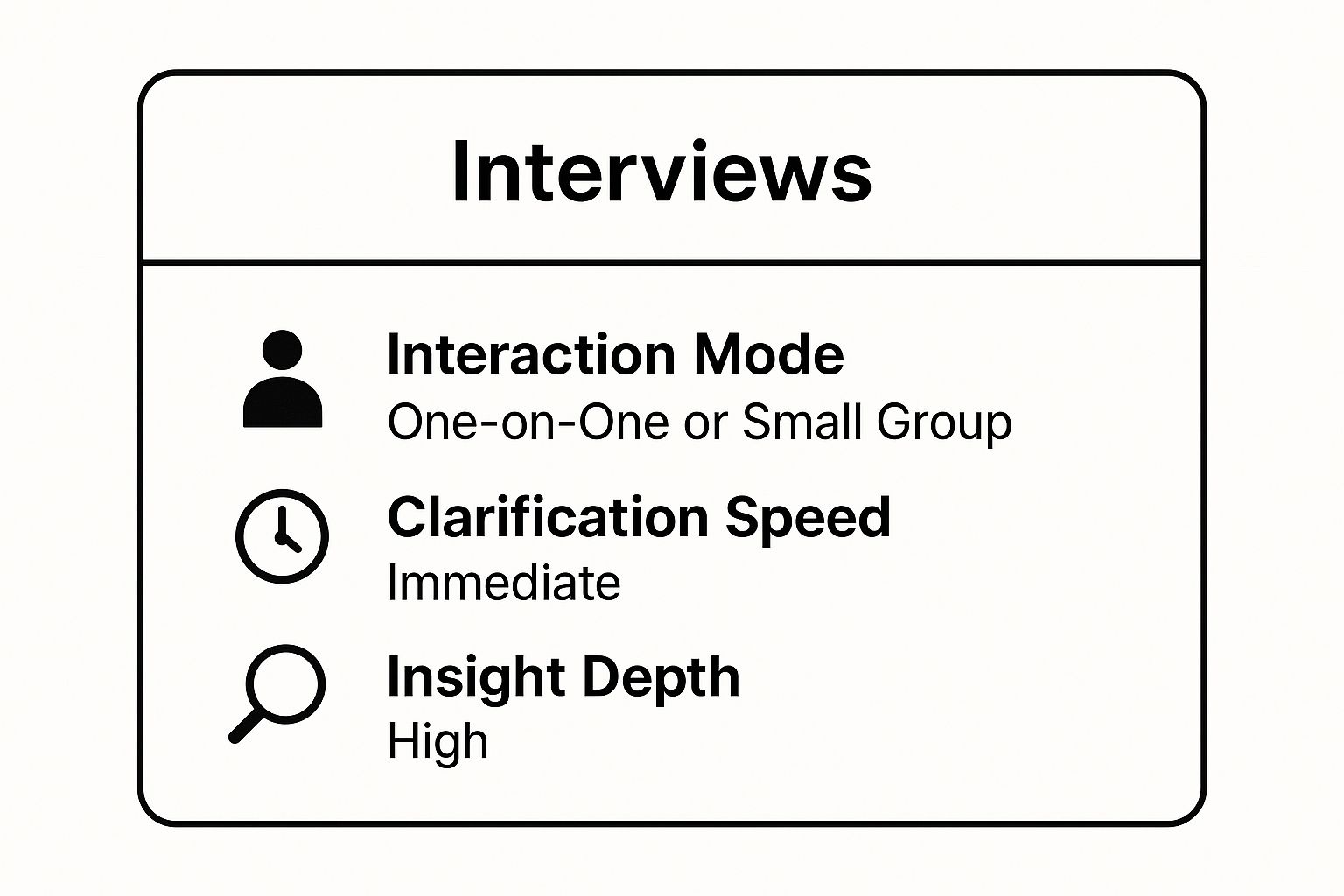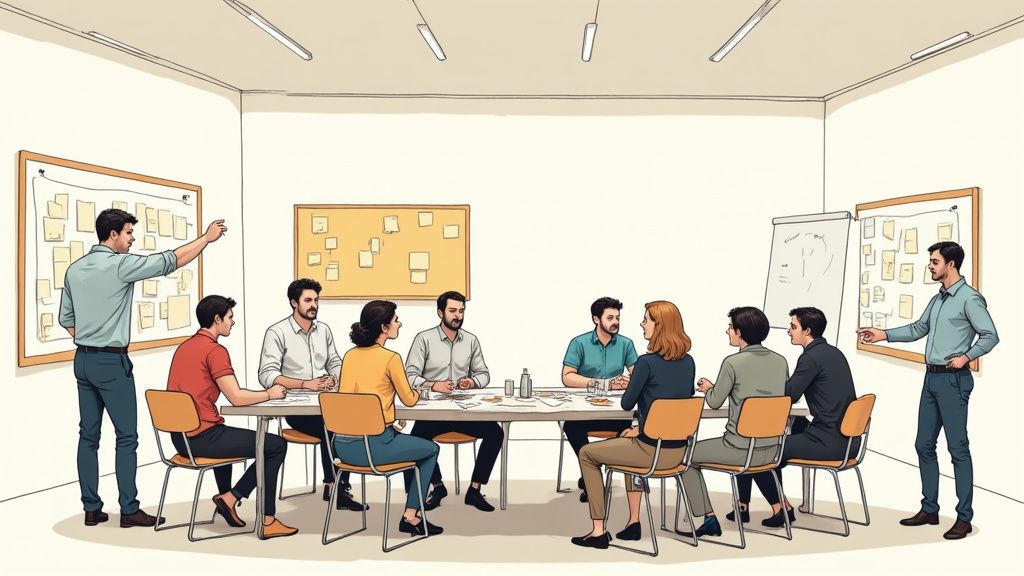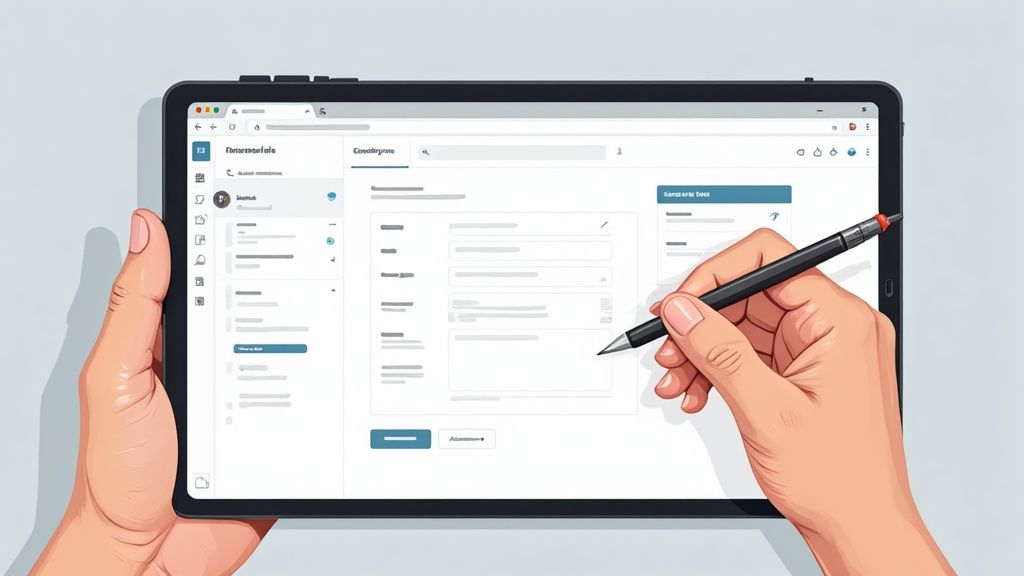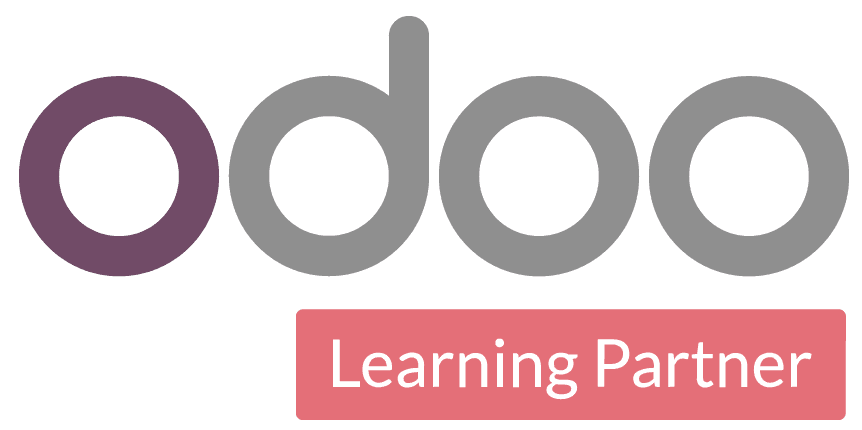Unlocking Project Success: The Art of Gathering Requirements
Effective requirements gathering is the cornerstone of successful projects. This detailed guide explores nine essential requirements gathering techniques, equipping you with practical strategies to define project scope and ensure stakeholder satisfaction. From interviews and workshops to prototyping and brainstorming, we’ll unpack each method, highlighting its strengths, weaknesses, and ideal application. You’ll learn how to select the right techniques for your specific project, apply them effectively, and analyze the results to gain actionable insights.
This listicle provides valuable information for diverse audiences:
- Startups and entrepreneurs: Building a robust digital presence requires a clear understanding of user needs and market demands. These techniques will help you gather the essential information to shape your product or service.
- Businesses seeking custom solutions: Whether it’s an ERP system or a marketing campaign, capturing precise requirements is crucial for successful implementation. This guide provides the tools you need to define your objectives and achieve desired outcomes.
- E-commerce retailers: Scalability and user experience are paramount in the competitive online marketplace. Learn how to gather requirements effectively to build platforms that meet customer expectations and drive growth.
- Enterprises undergoing digital transformation: Streamlining processes and automating workflows starts with a thorough understanding of existing systems and future needs. This guide helps you navigate complex requirements across departments and stakeholders.
Mastering requirements gathering techniques is not just about collecting information; it’s about building a shared understanding that fuels collaboration and drives project success. Let’s delve into the nine key methods that will transform your approach to project planning and execution.
1. Interviews
Interviews are a cornerstone of requirements gathering. They involve structured conversations, either one-on-one or with small groups of stakeholders, to elicit detailed requirements through direct questioning and discussion. This technique allows you to probe deeper into user needs, uncover hidden assumptions, and gain a richer understanding of the project context. Systematic questioning is crucial for extracting valuable knowledge, needs, and expectations from key stakeholders. For example, imagine building a banking system. Interviews with tellers reveal their daily workflow challenges, while discussions with managers highlight strategic business goals, and customer feedback unveils desired features and functionalities. Similarly, healthcare software benefits from interviewing doctors, nurses, and administrative staff, while e-commerce platforms thrive on input from business owners and end-users.
Actionable Tips for Effective Interviews
- Prepare, but stay flexible: Develop a structured interview guide with pre-defined questions, but be prepared to deviate and explore unexpected insights that emerge during the conversation.
- Open-ended questions: Phrase questions to encourage detailed responses and avoid simple yes/no answers. For example, instead of asking “Do you like the current system?”, ask “What are the biggest challenges you face with the current system?”
- Document everything: Record sessions (with permission) for later analysis and transcribe key takeaways. This creates a valuable repository of stakeholder input.
- Broaden your perspective: Interview a diverse range of stakeholders to gain a comprehensive understanding of the project. This ensures all perspectives are considered and mitigates bias.
- Validate and confirm: Follow up with summary documents and share findings with interviewees for validation, ensuring accuracy and buy-in.
The following infographic visualizes key data points about the interview technique, summarizing its core strengths for quick reference:

As the infographic highlights, interviews excel due to their direct interaction, enabling immediate clarification and fostering deep insights. This direct engagement with stakeholders offers a significant advantage over other requirements gathering techniques, making interviews an invaluable tool. Effective customer relationship management (CRM) can streamline the interview process, and you can learn more about using Odoo CRM for effective customer relationships to optimize your stakeholder engagement. When should you use interviews? They are particularly valuable in the early stages of a project, for complex projects requiring deep understanding, and when direct stakeholder interaction is crucial for capturing nuanced requirements. Interviews provide a robust foundation for informed decision-making, ensuring that the final product truly meets the needs of its users.
2. Workshops
Workshops are dynamic group sessions designed to collaboratively define and refine project requirements. Multiple stakeholders work together, guided by a facilitator, to identify needs, discuss solutions, and prioritize features. This interactive approach fosters shared understanding and consensus, crucial for aligning the project with stakeholder expectations. Workshops leverage the collective intelligence of the group, uncovering diverse perspectives and generating innovative solutions. For example, Joint Application Development (JAD) sessions are commonly used for complex enterprise software projects, bringing together business analysts, developers, and end-users to collaboratively define system requirements.

Agile story-writing workshops are another example, used in product development to create user stories that capture desired functionality from the user’s perspective. Cross-functional team workshops can also be highly effective for process improvement projects, gathering input from different departments to identify bottlenecks and optimize workflows. These collaborative sessions encourage active participation and buy-in from all involved. The collaborative nature of workshops also helps surface conflicting viewpoints early on, allowing for proactive resolution and minimizing potential roadblocks later in the project lifecycle.
Actionable Tips for Effective Workshops
- Skilled facilitator: Engage a skilled facilitator to guide the workshop, manage group dynamics, and ensure productive discussions.
- Clear objectives: Define clear objectives and ground rules at the outset to keep the workshop focused and on track.
- Optimal group size: Limit the group size to 6-10 participants for optimal interaction and effective communication.
- Visual aids: Utilize visual aids, whiteboards, and collaborative tools to capture ideas, foster engagement, and enhance understanding.
- Individual follow-up: Follow up with individual sessions as needed to address specific concerns or gather further details.
Workshops are particularly valuable when consensus-building is paramount, such as when diverse stakeholders have varying priorities. They excel in situations requiring collaborative problem-solving and innovative solution design. For complex projects or those involving significant organizational change, workshops provide a powerful platform to gather comprehensive requirements and build shared ownership. This collaborative approach ensures the resulting solution effectively addresses the needs of all key stakeholders.
3. Surveys and Questionnaires
Surveys and questionnaires are standardized data collection instruments used for gathering requirements from a large number of stakeholders efficiently. They leverage predetermined questions to collect both quantitative and qualitative data about user needs and preferences, offering a broad perspective on project requirements. This technique is particularly useful when you need to gather input from a dispersed group or a large number of individuals. For example, a customer satisfaction survey can help prioritize software features, while an employee needs assessment can inform the development of internal systems. Market research questionnaires are invaluable for gathering data during new product development, providing insights into customer demand and preferences.
Actionable Tips for Effective Surveys and Questionnaires
- Keep surveys concise: Shorter surveys significantly improve response rates. Focus on essential questions to avoid respondent fatigue.
- Use clear, unambiguous language: Ensure questions are easily understood and avoid jargon or technical terms that might confuse participants.
- Test your questions: Pilot test the survey with a small group to identify any ambiguities or issues before distributing it widely.
- Provide incentives: Offering small incentives can encourage participation and improve response rates. Gift cards or small discounts can be effective.
- Follow up strategically: For complex or critical responses, follow-up interviews can provide valuable clarification and deeper insights.
Surveys and questionnaires are especially valuable when you need to gather data from a geographically dispersed group, when a large sample size is required for statistical significance, or when you need to quickly collect a large amount of preliminary data. They provide a cost-effective way to gather a wide range of perspectives, providing a solid foundation for subsequent requirements gathering techniques. While they may not provide the same depth of insight as interviews, they offer a valuable starting point for understanding user needs and preferences. By carefully crafting questions and employing effective distribution strategies, surveys and questionnaires become powerful tools for gathering requirements and informing project decisions. This method allows for efficient data analysis, particularly for quantitative data, enabling informed decisions based on stakeholder feedback. When should you use them? They are best applied in the early stages of a project, when broad insights are needed, and when cost-effective data collection is a priority. This breadth of data makes surveys and questionnaires invaluable tools for requirements gathering.
4. Document Analysis
Document analysis is a crucial requirements gathering technique, particularly valuable at the outset of a project. It involves systematically examining existing documentation to understand the current state and identify implicit and explicit requirements. This technique includes reviewing business documents, technical specifications, process manuals, and other organizational materials to extract relevant information. It provides a foundation for understanding existing processes, systems, and user needs, helping to shape the future solution.
For example, analyzing existing system documentation provides crucial insights for modernization projects, revealing current functionalities and areas for improvement. Reviewing business process manuals is essential for workflow automation initiatives, mapping current procedures and pinpointing optimization opportunities. Examining regulatory documents is paramount for compliance-driven projects, ensuring the final product adheres to all legal and industry standards. Even analyzing customer support tickets can uncover recurring issues and highlight unmet user needs.
Actionable Tips for Effective Document Analysis
- Verify document currency and accuracy: Ensure the documents reviewed are up-to-date and reflect current practices. Outdated information can lead to inaccurate requirements and flawed solutions.
- Cross-reference multiple sources: Comparing information from various sources helps validate findings and uncover inconsistencies or gaps in existing documentation.
- Look for gaps between documented and actual processes: Formal documentation may not always align with real-world practices. Investigating these discrepancies can reveal critical unstated requirements.
- Organize findings systematically: Develop a structured approach to categorize and document extracted information. This ensures clarity and facilitates analysis.
- Validate findings with stakeholders: Confirming the accuracy of extracted information with relevant stakeholders ensures alignment and avoids misinterpretations.
Document analysis provides valuable context and a baseline understanding before engaging in other requirements gathering activities. It is especially useful when dealing with existing systems or processes, providing a foundation for improvement and innovation. This technique offers a cost-effective way to gain initial insights and inform subsequent stages of the project, ultimately contributing to a more robust and successful outcome. By leveraging existing documentation, document analysis streamlines the requirements gathering process and provides a solid starting point for building effective solutions.
5. Observation
Observation offers a powerful requirements gathering technique by directly observing users in their natural work environment. This ethnographic approach allows you to understand actual behaviors, workflows, and pain points. It captures real-world usage patterns that stakeholders might not articulate in interviews, providing valuable insights into unspoken needs and unanticipated challenges. Observing how users interact with existing systems reveals inefficiencies and opportunities for improvement.

For example, observing call center agents interacting with customers can inform the design of more intuitive CRM interfaces. Watching nurses’ workflows in a hospital setting can reveal opportunities to streamline processes and improve information systems. Similarly, studying retail workers’ interactions with point-of-sale (POS) systems can lead to optimized designs that enhance efficiency and customer experience. By observing real-world usage, you gain insights that go beyond stated requirements, leading to more user-centered solutions.
Actionable Tips for Effective Observation
- Spend enough time: Ensure your observation period is long enough to capture representative activities and workflows. Short observations may miss crucial details or fail to reveal recurring patterns.
- Be unobtrusive: Minimize your presence and avoid interrupting users’ natural workflows. This ensures you observe authentic behaviors and avoids influencing their actions.
- Detailed notes: Record observations meticulously, including contextual details and environmental factors. These details can provide valuable insights into the reasons behind user behaviors.
- Combine with interviews: Pair observation with follow-up interviews to understand the rationale behind observed behaviors and gain deeper insights.
- Permission and purpose: Always obtain permission before observing users and clearly explain the purpose of the observation. This fosters trust and ensures ethical data collection.
Observation is particularly valuable in the early stages of a project, especially when dealing with complex workflows or when users may struggle to articulate their needs effectively. This technique allows you to uncover hidden requirements and gain a deeper understanding of the user experience, leading to the development of more effective and user-friendly solutions. This direct observation of user behavior offers a rich layer of understanding that complements other requirements gathering techniques.
6. Prototyping
Prototyping involves creating early, simplified versions of a system or solution to visualize and refine requirements. These prototypes can range from basic paper sketches to interactive digital mockups, demonstrating functionality and user experience. This allows stakeholders to interact with a tangible representation of the system, providing valuable feedback early in the development process, preventing costly rework later. Prototyping bridges the gap between abstract requirements and concrete design, fostering shared understanding and facilitating more effective communication.

For example, imagine developing a mobile banking app. A paper prototype could quickly test different navigation flows, while an interactive prototype demonstrates core features like transferring funds. Similarly, for a new e-commerce platform, prototyping allows stakeholders to experience the checkout process, identifying potential usability issues early on. This hands-on approach helps uncover hidden requirements and refine design choices, ultimately leading to a more user-centered and effective solution.
Actionable Tips for Effective Prototyping
- Start with low-fidelity prototypes: Begin with simple sketches or wireframes to explore initial concepts before investing in high-fidelity mockups. This iterative approach saves time and resources.
- Clearly communicate prototype limitations: Emphasize to stakeholders that the prototype is a work in progress and may not represent the final product’s full functionality or polish.
- Iterate based on user feedback: Actively solicit feedback on prototypes and use it to refine design and functionality. Embrace the iterative nature of prototyping to continuously improve the design.
- Focus on key functionality first: Prioritize prototyping core features and user flows, ensuring that the essential functionalities are well-defined and user-friendly before adding less critical elements.
- Use appropriate tools for the audience: Choose prototyping tools that align with the project’s complexity and the stakeholders’ technical proficiency. Simple tools might suffice for basic prototypes, while complex projects may require more advanced software.
Prototyping is particularly valuable during the early stages of a project, when requirements are still fluid, and for projects involving complex user interfaces or workflows. By enabling early visualization and interaction, prototyping significantly reduces the risk of building a product that doesn’t meet user needs. This iterative, user-centered approach leads to more refined requirements, improved user satisfaction, and ultimately, a more successful project.
7. Use Cases and User Stories
Use cases and user stories are powerful requirements gathering techniques centered around user behavior. They provide structured narratives illustrating how users interact with a system to achieve specific goals. Use cases offer comprehensive, step-by-step scenarios, outlining every interaction between the user and the system. User stories, on the other hand, offer concise, user-focused descriptions of desired features, typically following the format: “As a [user type], I want [goal] so that [benefit].”
Imagine developing an e-commerce platform. A use case might detail the entire process of a customer adding items to their cart, proceeding to checkout, and completing a purchase. A corresponding user story might be: “As a customer, I want to easily add items to my shopping cart so that I can quickly purchase multiple products.” Similarly, in healthcare, a use case could describe a doctor accessing and updating patient records, while a user story might state: “As a doctor, I want secure access to patient medical history so that I can provide informed care.” Learn more about how Use Cases and User Stories apply to ERP software development here.
Actionable Tips for Effective Use Cases and User Stories
- Write from the user’s perspective: Focus on the user’s goals and motivations, not technical implementation details.
- Include acceptance criteria: Define specific, measurable, achievable, relevant, and time-bound (SMART) criteria to determine if a user story or use case has been successfully implemented.
- Keep stories independent and testable: Ensure each story represents a distinct piece of functionality that can be tested independently.
- Use personas: Create representative user profiles (personas) to understand different user types and their specific needs.
- Prioritize stories based on user value: Focus on delivering the most valuable features to users first.
Use cases and user stories are particularly valuable in agile development environments. They promote collaboration, facilitate communication between stakeholders and developers, and ensure the final product meets user needs. They are best utilized when user-centric design is paramount, for projects with evolving requirements, and when frequent feedback is desired. By focusing on user interactions and desired outcomes, these techniques pave the way for a user-friendly and effective final product.
8. Brainstorming
Brainstorming is a dynamic requirements gathering technique centered around creative group problem-solving. It encourages participants to freely generate ideas without immediate judgment, fostering a collaborative environment where innovative solutions can emerge. This technique helps identify out-of-the-box solutions and uncover requirements that might not surface through traditional, more structured questioning methods. By leveraging the collective knowledge and creativity of a group, brainstorming can unlock valuable insights and perspectives.
Actionable Tips for Effective Brainstorming
- Establish clear ground rules: Set guidelines for participation to ensure everyone feels comfortable contributing and the session stays productive. Encourage active listening and respectful communication.
- Embrace wild ideas: Foster an environment where participants feel safe suggesting even seemingly outlandish ideas. Often, these unconventional thoughts spark truly innovative solutions. Build on others’ suggestions to create momentum and synergy.
- Visual aids and sticky notes: Use visual tools like whiteboards, flip charts, or digital sticky notes to capture and organize ideas. This makes the process more engaging and facilitates collaborative thinking.
- Separate idea generation from evaluation: Dedicate a specific phase for generating ideas without criticism. Once a sufficient number of ideas are collected, then move on to evaluating and prioritizing them.
- Follow up: After the brainstorming session, conduct a follow-up analysis to prioritize the most promising ideas and assess their feasibility. This ensures the output of the session translates into actionable next steps. Learn more about brainstorming effective marketing campaigns.
Brainstorming sessions are ideal for various situations: feature brainstorming sessions for new product development, problem-solving workshops to identify system improvements, or innovation sessions to explore new business processes. For example, a software development team could brainstorm potential features for a new mobile app, while a customer service team could brainstorm ways to improve customer satisfaction. When should you use brainstorming? It’s particularly effective during the early stages of a project, when exploring new ideas, and when seeking innovative solutions to complex challenges. Brainstorming can uncover hidden requirements and propel project success by tapping into the collective intelligence of the team.
9. Focus Groups
Focus groups are a valuable requirements gathering technique involving moderated group discussions with representative users or stakeholders. These interactive sessions explore attitudes, perceptions, and requirements surrounding specific topics. The power of group dynamics allows for a deeper exploration of user needs and preferences than individual interviews, revealing shared experiences and diverse viewpoints. This technique provides rich qualitative insights through guided discussions and the interplay of participant perspectives. For example, a software company designing a new project management tool might convene focus groups with project managers to understand their workflow challenges and desired functionalities.
Actionable Tips for Effective Focus Groups
- Recruit diverse but relevant participants: Aim for a mix of backgrounds and experiences within your target user group. This diversity enriches the discussion and ensures a wider range of perspectives are considered.
- Use skilled moderators: A skilled moderator guides the discussion, manages group dynamics, and ensures all participants have a voice. Their expertise is critical for extracting valuable insights and keeping the conversation focused.
- Create a comfortable environment for open discussion: A relaxed and welcoming atmosphere encourages candid feedback. Participants should feel safe sharing their honest opinions and experiences.
- Prepare a discussion guide but remain flexible: A structured discussion guide provides a framework, but the moderator should be adaptable, allowing for spontaneous exploration of emerging themes.
- Record sessions for later detailed analysis: Recording and transcribing sessions allows for in-depth analysis of the discussions, capturing nuances and identifying key themes that might be missed during the live session.
Focus groups are particularly useful when exploring complex topics, generating innovative ideas, and gaining a deep understanding of user needs and preferences. They excel at uncovering hidden assumptions and revealing the underlying reasons behind user behavior. When should you use focus groups? They are especially beneficial during the early stages of a project for exploring user needs, evaluating new product concepts, and gaining insights into user expectations. By leveraging the power of group interaction, focus groups provide a rich source of information, contributing significantly to the development of user-centered products and services.
Requirements Gathering Techniques Comparison
| Technique | Implementation Complexity 🔄 | Resource Requirements ⚡ | Expected Outcomes 📊 | Ideal Use Cases 💡 | Key Advantages ⭐ |
|---|---|---|---|---|---|
| Interviews | High – requires skilled interviewer, scheduling effort | High – time-consuming, one-on-one sessions | Deep, detailed insights, uncover hidden needs | Complex or sensitive topics, detailed stakeholder requirements | Detailed info, immediate clarification, rapport building |
| Workshops | Medium – needs facilitation, group management | Medium – requires multiple participants | Consensus, prioritized requirements, creative solutions | Multi-stakeholder alignment, quick consensus, brainstorming | Efficient multi-stakeholder input, promotes buy-in |
| Surveys and Questionnaires | Low – standardized tools and questions | Low – scalable to large groups | Quantitative data, broad feedback | Large user bases, quantifiable preferences, initial data gathering | Cost-effective, anonymous feedback, reduces bias |
| Document Analysis | Medium – requires careful review and interpretation | Low – uses existing documents | Historical context, baseline requirements, compliance insights | Understanding current state, compliance, background research | Cost-effective, always available, uncovers existing constraints |
| Observation | High – time-intensive, requires skilled observers | Medium – prolonged presence needed | Real behavior insights, tacit knowledge, context-rich data | Workflow analysis, uncovering unarticulated requirements | Reveals actual behavior, captures informal processes |
| Prototyping | Medium to High – depends on fidelity and iteration | Medium – design skills and tools required | Early validation, requirement refinement, reduced misunderstandings | Visualizing concepts, iterative feedback, usability testing | Tangible feedback, reduces miscommunication, supports iteration |
| Use Cases and User Stories | Medium – requires good writing, structured approach | Low to Medium – mostly documentation effort | User-focused scenarios, testable and prioritized requirements | Agile development, user-centered design, defining interaction flows | Clear user goals, supports testing, easy stakeholder understanding |
| Brainstorming | Low to Medium – needs skilled facilitation | Low – quick sessions, few resources | Innovative ideas, broad requirements spectrum | Idea generation, creative problem solving, early-stage projects | Encourages creativity, team engagement, quick and inexpensive |
| Focus Groups | Medium – skilled moderation needed, participant management | Medium – group sessions, recruitment effort | Rich qualitative insights, group dynamics, consensus indication | Exploring perceptions, attitude assessment, qualitative insights | Diverse perspectives, interaction-driven insights |
From Insight to Action: Mastering Requirements for Project Excellence
Effective requirements gathering is the bedrock of successful projects. This curated collection of nine techniques provides a robust toolkit for transforming stakeholder input into actionable insights. Mastering these techniques empowers you to foster collaboration, mitigate risks, and ultimately deliver exceptional results. Choosing the right combination of techniques, tailored to your project’s specific context, is key to maximizing effectiveness.
Key Takeaways: Optimizing Your Approach
Let’s recap the most important takeaways from our exploration of requirements gathering techniques:
- Understand Your Context: The best technique isn’t universal. Consider project size, complexity, and stakeholder availability when selecting your approach.
- Embrace Diversity: Combining multiple techniques offers a more holistic understanding, mitigating blind spots inherent in single-method approaches.
- Prioritize Actionable Insights: Requirements should be clear, concise, and testable, forming a solid foundation for development and design.
- Facilitate Collaboration: Effective requirements gathering is a collaborative process. Involve stakeholders early and often to ensure alignment.
Putting Knowledge into Practice: Next Steps
Now that you’re equipped with these powerful techniques, it’s time to put them into action. Here’s how to get started:
- Assess Your Current Approach: Identify areas for improvement in your existing requirements gathering process.
- Experiment and Iterate: Don’t be afraid to try different techniques and adapt your approach based on project needs.
- Document and Refine: Maintain clear and accessible documentation of gathered requirements throughout the project lifecycle.
- Champion Communication: Foster open communication channels to ensure everyone stays informed and aligned.
The Value of Precision: Delivering Exceptional Results
Mastering requirements gathering techniques isn’t just about ticking boxes; it’s about building a foundation for project excellence. Accurate, well-defined requirements lead to:
- Reduced Rework: Clear expectations minimize costly revisions and delays later in the project.
- Improved Stakeholder Satisfaction: Collaboration and clear communication foster buy-in and alignment.
- Increased Project Success Rates: A solid foundation ensures projects are delivered on time, within budget, and meet stakeholder needs.
By investing in robust requirements gathering, you’re investing in the success of your entire project. From startups to enterprises, the ability to translate vision into actionable specifications is a crucial differentiator in today’s competitive landscape.
KP Infotech understands the crucial role of requirements gathering in crafting successful digital solutions. Our expertise enables us to leverage these techniques, delivering tailored strategies that align with your unique business objectives. Contact us today at KP Infotech to discuss how we can help you unlock the full potential of your next project.
Article created using Outrank

